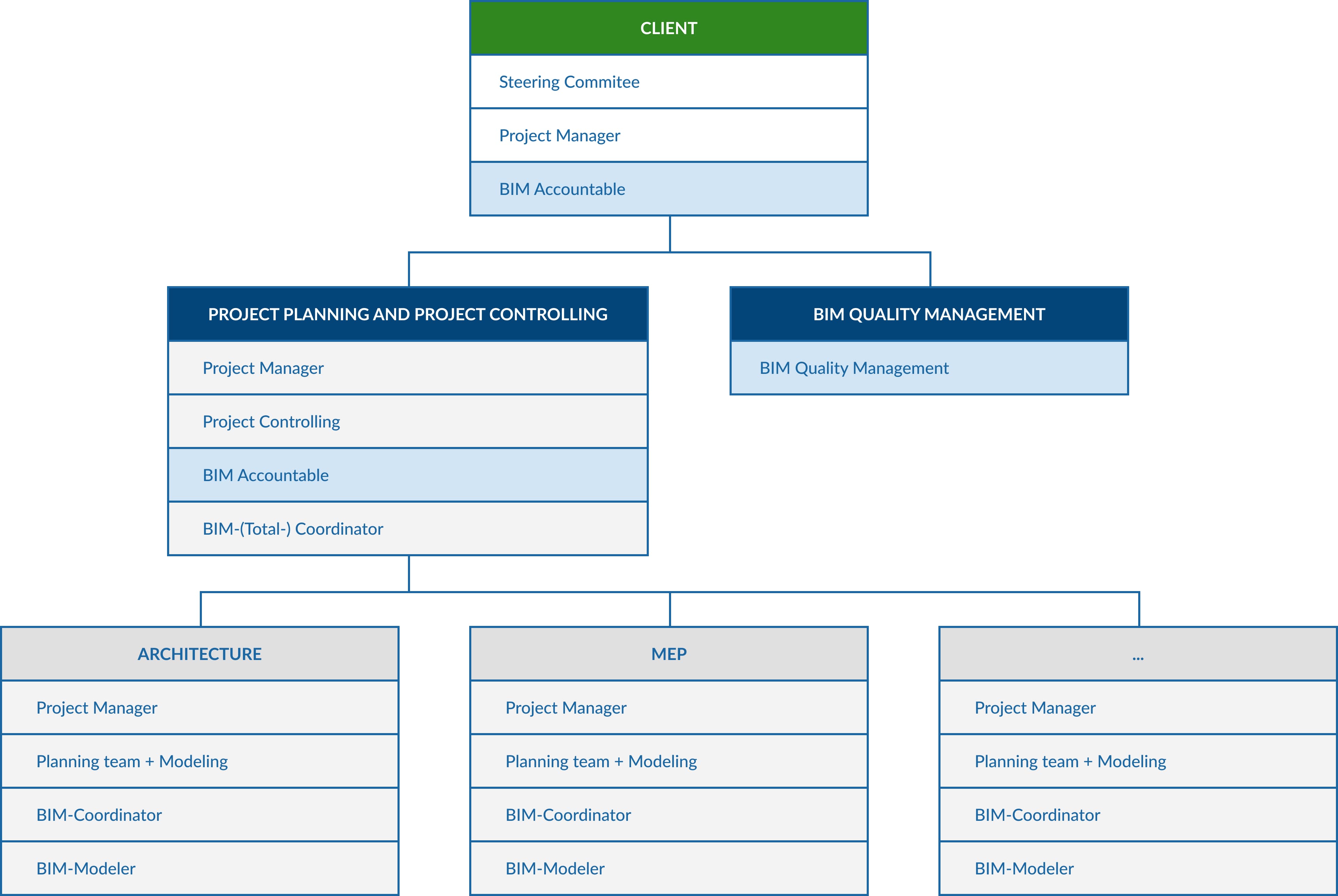BIM in project management: the most important BIM roles from client's perspective
Every BIM project needs a clearly defined distribution of roles. But what exactly are these roles and what responsibilities do they have? We have already dealt with this question in broad outline in the article The BIM roles and organizational structure. In the current article, we will now go one step deeper into the details. We will first concentrate on the roles that are to support BIM projects on the client side and ensure that they run smoothly. The roles from the perspective of the contractor will be dealt with in a future article.
Client / building owner
The client is the highest organizational level of an organizational structure within a building project. Just as he or she defines the project goals, i.e. the requirements for the building to be constructed, he or she also specifies the BIM goals and commissions all related services.
Overview of tasks:
- The client passes on the information requirements of the company and those of the operator of the property to the person responsible for BIM (also known as the information manager), so that he or she can formulate and communicate them in the project in the appropriate manner and so that the requirements are actually taken into account and implemented.
- The client can also specify in-house standards, e.g., define compliance with process specifications, require the use of templates and checklists, and much more, and demand that they be used or implemented as part of the project.
- This often includes the definition of the required interface connection within an existing software architecture. An essential aspect here is in particular the software used in the completed building, for example asset management, facility management, building control technology, or smart building software. Ideally, the software itself and also the use cases to be mapped are already defined before the start of planning.
- In larger companies, it is also not unusual for the client to provide the Common Data Environment (CDE) collaboration platform and to prescribe its use. In this context, the client can also define the exact use of the collaboration platform.
- The client is usually also involved during the execution phase in order to bring about quick decisions on site (such as change requirements, reorders, payment processing, etc.) and is responsible for the subsequent acceptance and final invoice negotiations after completion of the construction project.

BIM Accountable of the client (also called information manager)
The BIM Accountable organizes the BIM project for the client. He or she is the digital equivalent of the project manager. The BIM Accountable is responsible for ensuring that the data and information provided by the project participants meet the interests of the client. The goal of the tasks is specifically focused on meeting the employer’s information requirements (EIR).
Overview of Tasks:
- The tasks of the BIM Accountable are organizational in nature. He or she organizes the BIM project on the client side. Here, the role is responsible in particular for defining the client’s information requirements with regard to digital project execution and results. Together with the project managers (e.g., steering committee and project management), The BIM Accountable is responsible for formulating the BIM goals and drafting the project-specific employer’s information requirements (EIR). The milestones for the exchange of information also emerge from this.
- In this context, he or she also evaluates the project progress for the client with regard to the implementation of the BIM objectives and prepares review reports and makes recommendations for the release of the milestones to the client.
- The BIM Accountable defines the service profiles of the BIM manager and the BIM total coordinator. In addition, the BIM Accountable, in coordination with the BIM manager, is also responsible for the requirement profiles of all other BIM participants. In this way, the BIM Accountable has a continuous influence on the scope of services of the participants and can therefore specify the required qualifications of the project participants.
- His or her tasks also include communicating the BIM objectives or the EIR to the contractors and coordinating them with them. This concerns goals, applications, model quality and depth. He or she is therefore also involved in defining the LOG and LOI requirements for the respective project phases. The most important contact in this context is the BIM Manager. In consultation with the BIM Manager, the BIM Accountable can also help determine the organization of the data exchange and the data exchange formats.
- He or she releases the implementation of the BIM objectives to be described by the BIM Manager or the contractors within the framework of a BEP (BIM execution plan). Within this framework, he controls the processes and specifications specified by the client for digital project execution in the client’s interest.
- His area of responsibility also includes the organization and control of the exchange of information between the project participants within the framework of the collaboration platform, which may already have been specified by the client (in the EIR) or defined between the participants within the framework of the BAP. In this way, all in-house standards and guidelines of the client can be organized and integrated by the BIM Accountable.
- Furthermore, there are also interfaces to the BIM Quality Management in that he provides specifications for the BIM Quality Management and quality assurance and makes all arrangements and guidelines for quality characteristics with the BIM quality management.
- In this context, it provides the client with all the evaluations it needs for its decisions in the project and keeps it informed about what is happening during project execution.
BIM Quality Management
BIM Quality Management acts on behalf of the client and is responsible for the overall quality management of the BIM method in the project.
Overview of tasks:
- The quality of the BIM method in the project, taking into account the contractually agreed cost and schedule targets, is always the focus of BIM Quality Management.
- The BIM quality management participates together with the BIM Accountable in the definition of the BIM objectives in the project as well as the performance profiles of the BIM manager and the overall BIM coordinator.
- He participates in all project agreements and in particular in the BIM execution plan (BEP). He attaches particular importance to BIM key performance indicators and performance parameters as well as to the inspection key performance indicators that are used in the regular inspections in order to be able to efficiently check the scope and quality of the services. These can be, for example, specifications and handling of types and numbers of collisions and their elimination rates, but also specifications and regulations on the performance of the document management system. Only on the basis of these specifications can quality management classify the quality of the services.
- BIM quality management ensures the implementation of the specifications made for the BIM method by monitoring the quality of the work of the BIM manager and the BIM Total-coordinator.
- Participation in the coordination rounds of the BIM Total-coordinator is also not excluded, as the potential for conflict becomes apparent during the meetings.
- BIM quality management is also used as an inspection authority during the acceptance of the BIM model or the partial models between the service phases. It monitors the awarding of contracts and the handover of the BIM to the contractors. BIM quality management is also responsible for monitoring the revision and acceptance of the BIM model and its handover to the operator.
BIM Manager
The BIM Manager generally ensures the full functionality of the BIM method in the project. He supports the client and BIM Accountable with regard to the strategy and management of the BIM project. His activity is to be separated from the activity of the BIM Accountable person in the sense that he has deeper knowledge about the application forms of the BIM and the model development degree. Finally, he is responsible for the definition and determinations in these areas in coordination with the BIM Total-coordinator.
Overview of tasks:
- His central tasks are in the area of management and strategy of the BIM application. He receives technical support from the overall BIM coordinator and is supervised by BIM quality management.
- He determines the BIM maturity level in consultation with the client. A distinction must be made between the following levels:
- BIM level 0, which is exclusively about the collaborative cooperation of the project participants,
- BIM level 1, which involves collaborative cooperation and the creation of 3D models,
- BIM level 2, where the various degrees of information enrichment by further dimensions are already added, and
- BIM level 3, where only non-proprietary data formats are used and, for example, a cloud-based platform and the building model is used throughout the lifecycle.
- This role defines and updates the required content and level of detail in terms of geometry and information (LOG and LOI requirements, also in terms of coordination and logistics) per cost group and project phase. This is done in cooperation with the BIM quality management and its already defined specifications.
- The BIM Manager defines and helps to coordinate the use of software and the import and export interfaces and data exchange formats to be used.
- It provides technical guidelines for data storage, creation and provision. He is also responsible for managing access rights in the project platform or Common Data Environment (CDE)- The role can also set up workflows for this purpose.
Together with the BIM coordinators, he records all other specifications in a BIM execution plan (BEP). - The BIM Manager is responsible overall for the organization and coordination of processes in BIM planning by defining processes and intervals for data merging, quality checks, data transfers and reports.
- He or she analyzes the BIM-relevant communication, coordination and information requirements within the specialist areas in the project and ensures the appropriate implementation and corrections.
- In this context, the BIM manager can also play a supporting role to the project manager and BIM Total-coordinator. In this context, he or she coordinates the BIM processes with the parties involved, moderates model coordination meetings and participates in the creation of CAD modeling guidelines.
- The execution of the BIM quality check in the project is also part of the tasks. For this purpose, he can define and prescribe rules and procedures. He can define regulations to ensure data quality and implementation of BIM. Within the scope of reporting to evaluate BIM implementation, he passes on the results to BIM quality management and has them reviewed.
- He or she continues to be responsible for communicating the required BIM methods and supports the contractors through training or directly assists with implementation if there are teething problems. If the contractor decides to become certified in this area, the BIM manager can assist in the development of a corresponding BIM training and certification program and support the client in the measures for certification.
Coming Soon
After we have presented the most important BIM roles from the perspective of a client in the current article, in the next article we will focus on the essential BIM roles from the perspective of the contractor(s), e.g. BIM Total-coordinator, BIM coordinator and BIM modeler. We are pleased if you liked our article and if we have awakened your interest in further articles on BIM and project management topics.



